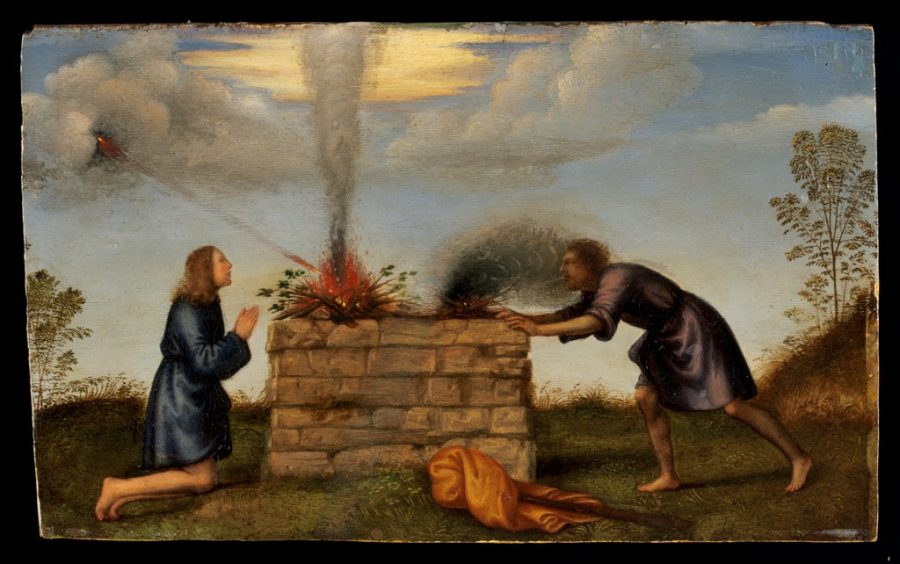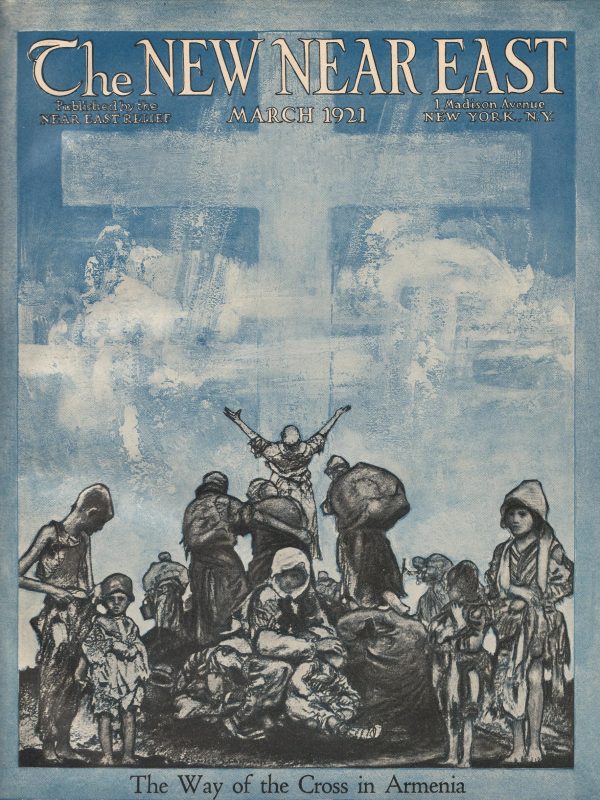
Mariotto Albertinelli (1474 – 1515), The Sacrifice of Cain and Abel, 1510, Harvard Art Museums
1 And Adam knew Eve his wife; and she conceived, and bare Cain, and said, I have gotten a man from the LORD.
2 And she again bare his brother Abel. And Abel was a keeper of sheep, but Cain was a tiller of the ground.
3 And in process of time it came to pass, that Cain brought of the fruit of the ground an offering unto the LORD.
4 And Abel, he also brought of the firstlings of his flock and of the fat thereof. And the LORD had respect unto Abel and to his offering:
5 But unto Cain and to his offering he had not respect. And Cain was very wroth, and his countenance fell.
6 And the LORD said unto Cain, Why art thou wroth? and why is thy countenance fallen?
7 If thou doest well, shalt thou not be accepted? and if thou doest not well, sin lieth at the door. And unto thee shall be his desire, and thou shalt rule over him.
8 And Cain talked with Abel his brother: and it came to pass, when they were in the field, that Cain rose up against Abel his brother, and slew him.
9 And the LORD said unto Cain, Where is Abel thy brother? And he said, I know not: Am I my brother’s keeper?
10 And he said, What hast thou done? the voice of thy brother’s blood crieth unto me from the ground.
11 And now art thou cursed from the earth, which hath opened her mouth to receive thy brother’s blood from thy hand;
12 When thou tillest the ground, it shall not henceforth yield unto thee her strength; a fugitive and a vagabond shalt thou be in the earth.
13 And Cain said unto the LORD, My punishment is greater than I can bear.
14 Behold, thou hast driven me out this day from the face of the earth; and from thy face shall I be hid; and I shall be a fugitive and a vagabond in the earth; and it shall come to pass, that every one that findeth me shall slay me.
15 And the LORD said unto him, Therefore whosoever slayeth Cain, vengeance shall be taken on him sevenfold. And the LORD set a mark upon Cain, lest any finding him should kill him.
16 And Cain went out from the presence of the LORD, and dwelt in the land of Nod, on the east of Eden.
(Genesis 4:1-16-KJB)
This study is designed to reveal some theological peculiarities of the most systematic, legally defined pattern of mass violence – the phenomenon of genocide. In this paper ‘the syndrome of Cain’ is considered as a paradigmatic and descriptive model for understanding and interpreting general theological outline of the phenomenon of genocide through the story of Cain and Abel. Famously, this is the story of the first murder, the story of first human violence, and the first narrative in the Bible built around the phenomenon of sacrifice. This research points out the issues of struggling for superiority, enmity, the separation of ‘us’ from ‘the others’, and scapegoating ‘the others’ which are very vividly present in almost all known genocides.
‘The syndrome of Cain’ is a descriptive, metaphoric, and paradigmatic unit and is on its way to further conceptualization. Here the following stages are highlighted and proposed:
- The competition for superiority – In the story, the competition is well-described after God accepts the offerings of Abel and rejects those of Cain. Cain’s reaction is being ‘wroth’, i. e. angry. That means Cain is dissatisfied with his own failure. But what stands close to the genocidal ideologies, is that there is perpetrators’ feeling of disturbing inferiority of themselves and searching for ways out of it.
- The enmity – Enmity is the stage when ‘us’ is separated from ‘them’. This stage derives from long-preceded envy just like in the case of Cain. In the psychology of genocides, it is well-studied the phenomenon of victimization stating that eliminating the superiority of others is inside the psychology of the perpetrators of genocides.
- Sacrificial mentality, i. e. sacrificing ‘the other’ in order to construct/regain ‘us’ – It is not accidental that the story of the first murder is connected with the phenomenon of sacrifice. Biblical commentaries come to prove that Cain was in search of the positive acceptance of God, but meanwhile, envying the superiority of his brother whose effort, whose gift was accepted and he himself was the one, whose sacrifice was rejected. Thus, he had to find ‘bloody’ sacrifice and this bloody sacrifice was Abel. One of the distinguished interdisciplinary scholars René Girard in his works repeatedly proves that the sacrifice and violence walk side by side and points out various expressions of sacral violence in religions (see: René Girard, Violence and the Sacred. Baltimore & London: The Johns Hopkins University Press, 1977; René Girard, The Scapegoat. Baltimore: The Johns Hopkins University Press, 1986.) Another scholar of Biblical and Religious Studies, Adolf Wendel, on the pattern of early Israel explains that every mass slaughter was a communion-sacrifice (see: Adolf Wendel, Das Opfer in der altisraelitischen Religion. Leipzig, Pfeiffer, 1927).
‘The syndrome of Cain’ is suggested to be used as a metaphoric, paradigmatic and descriptive model for understanding and interpreting the general outline of ideological cores of genocides in terms of the separation of “us” from “the others”. It points out the problems of enmity, struggling for superiority, and scapegoating “the others”. This study offers the most essential observations leaving the thorough study to be fully proposed in an upcoming article.
Our proposition to use ‘the Syndrome of Cain’ has its twofold bases: the biblical metaphoric story of the first murder, the murder of Abel by his brother Cain, and the paradigm that constitutes genocidal ideology. Methodologically, this research is an interdisciplinary study in terms of theology, religious studies, and the philosophy of history.

Pietro Novelli (1603-1647), Cain and Abel, Galleria Nazionale d’Arte Antica, Roma
Thus, the ideological cultivation of genocide crystallized in the story of the first murder, constitute the following stages:
1. The competition for superiorityGod accepts the offerings of Abel and for some reason rejects that of Cain’s. Cain’s reaction is being ‘wroth’ and his ‘countenance is fallen,’ he is dissatisfied by his own failure. Nevertheless, God gives the opportunity to rise up to a level in which Cain’s offerings/sacrifice would be acceptable. But what stands close to the genocidal ideology, is that there is a feeling of superiority of the future victims, and a decision to eliminate that superiority of others. Explaining the steps of scapegoating the Jews, in his brochure Gordon Allport explains: “Feelings of inferiority may lead to scapegoating, in order that the individual may convince himself of his own value and strength” (Gordon W. Allport, ABC’s of Scapegoating. ADLBB, 1948, p. 18) and “Many Germans scapegoated the Jews to establish themselves as acceptable Nazis and thus avoid persecution for themselves” (Ibid. p. 19). By the same logic the Armenian, the Jews, and the Tutsis in the ideological pamphlets and propaganda leaflets were called vermin, harmful bacteria that obstacle the safe and sane evolution and development of a certain organism, as such were the Ottoman Empire or Nazi Germany.
2. The enmityThe enmity is the stage when ‘us’ is separated from ‘them’. This stage derives from long preceded hatred. In this stage of ‘Cainic syndrome,’ the theological interpretations lay stress upon the following question ‘Am I my brother’s keeper?’, which indicates the psychological separation of Cain from his brother: Abel is ‘the other one’ so on, and it is hardly possible to bring him back to the sphere of brotherhood, Cain has separated Abel from himself. Though, the enmity is not the guarantee for every group to commit genocidal acts against the others: there are additional components needed to reach out to the genocidal mind.
3. The philosophy to eliminate an enemyThough the Bible does not explicitly say why Cain killed Abel, it has many commentaries both in the Rabbinical literature and in Christian theology. I will pass round focusing on these commentaries. This point is most crucial when the unconscious and conscious enmity shifts into systematic, often – a political necessity to struggle against an enemy that stands in their way of redemption/liberation/well-being. The word philosophy here is not used metaphorically. During the Armenian genocide, the Young Turks’ government borrowed, in some cases shifted the ideas of well-known philosophers, both Turkish and European to have self-justifying firm ground to annihilate the Christians of the Ottoman Empire, especially – the Armenians. These philosophers were the French illuminators of the XVIII century, as well as Friedrich Nietzsche, Auguste Comte, Arthur de Gaubineau, Gustave Le Bon, and others. In the case of the Holocaust Third Reich had its beloved philosophers; and some works of the latter seemed to lead to the Holocaust directly by their anti-Semitic hatred shifted to politically, culturally, and economically acceptable necessity and some other philosophers’ works were accommodated to the Nazi purposes. In the case of the Rwandan genocide, the perpetrators’ regime turned to social Darwinism – a theory that was rejected long ago but apparently had the potential to nourish genocidal ideology towards the Tutsis.
4. Sacrificial mentality“And the goat shall bear upon him all their iniquities”
(Leviticus 16.22-KJB)
Obviously and famously, the story of the first murder is connected with the phenomenon of sacrifice. The core of this story is the sacrifice to God. Moreover, in many commentaries, especially in those of Syriac fathers, it is said that Abel is sacrificed by the hands of Cain and the commentaries come to prove that Cain was searching for the superiority, the positive attitude of God, choosing the murder of his brother whose effort, whose gift, whose social status as a shepherd was higher than his, and he was the one, whose sacrifice was rejected, who was cultivator whose fruits did not have blood inside: he had to find bloody sacrifice and this bloody sacrifice was Abel. One of the famous philosophers – Rene Gerard, says that sacrifice and violence walk side by side.
The sacrificial meaning is discussed both in the philosophy of the Holocaust and the Armenian theological interpretation of the Armenian Genocide. Not sinning against the interreligious ethics, but, simultaneously, keeping scientific ethics, it has to be said that the religious components were vividly present in the Armenian Genocide. Letting alone that the calls for holy war were directed against the Christians of the Ottoman Empire, there was another component to which a scholar of Theology/Religious Studies should pay attention: the ritualization of violence and murders during the Armenian Genocide. The key points are as follows: the outbursts of barbarism towards Armenian clergy, the ritualization of violence, ritual murders, the cross during the Armenian Genocide (insults against the cross, crucifixion of the Armenians–making them die as their God died in the cross), speculation of the name of Jesus Christ (“Your Jesus doesn’t have might/power to spare you from our hands”, “our God is the only true God” etc.), religious oaths, insults and appeals, labeling, acts of vandalism against Christian religious sites and shrines, apocalyptic stories told such as the Turks are going to enter the heavenly gates while the Armenians-the infidels, will go to hell because of rejecting to accept the only true faith, etc.
So famously, the scapegoating leads to sacrifice. The paradigm of Syndrome of Cain is thus a diagnosis of a cultural disease called ‘genocidal act’ that bursts out through the aforementioned subsequent complex of steps altogether. However, this does not mean that crime can be justified as the perpetrators en masse are ill with this syndrome and because of this so-called ‘illness’, they have ‘mitigating circumstance’, because this is a psychological behavior that has penetrated into the unconscious depths with an archetypal pattern of negative culture. In this way, the dialectics of the phenomenon of genocide has its profound roots metaphorically described in the Bible as the first murder in the history of mankind. My intention to choose the ‘Cainic’ act as a symbol and expression of murder is to propose another model of scholarly analogy to call by the name of heroes of mythology or by the name of various religious characters (like those very well-known – the complex of Electra, the complex of Oedipus, the complex of Judas, etc.). The syndrome of Cain constitutes the actions describing human enmity, murderous behavior individually, and en masse.

Focusing on the general conceptual background of genocidal ideology, there are some certain accents on biological materialism, the influence of Friedrich Nietzsche and positivistic propositions, theories of Auguste Comte, Arthur de Gaubineau, and Gustav Le Bon.
It is well known that biological materialism and social Darwinism see man as one of the species that struggles to survive and the result is that the most capable one survives: as we know this is natural selection. And the death of one man by the hands of the other is also considered as a struggle for the right of life and at the end, the strongest, the best, the one who most deserves living, wins. In the journals of Young Turks, (e.g. in the official journal ‘Tanin’) this concept has its profound room, and Turkish author Shukru Hanioglu speaks of Darwinist, as well as positivist orientations of the Young Turks [Hanioğlu M. Ş., The Young Turks in Opposition. New York, Oxford: Oxford University Press, 1995, pp. 12-13] – the Ottoman Government of the perpetrators of the genocide of the Christians in the Ottoman Empire. Numerous studies have been dedicated to investigating the peculiarities of the Nazi racial theories and their consequences for the Jews and in the Rwandan genocide – the social Darwinism as well.
When the national enmity + philosophies of their time are put inside the politics, we have an ideology. Political concepts with special attention to revolutionary theories, utopian and racist ideals (Ittihatism, Nazism) together with certain antireligious state policies are very much typical for genocidal ideology.
Together with political concepts, there is a social ideal. In the case of Armenian and Rwandan genocides and the Holocaust we can trace genocide perpetrators’ three ideals on social construction – Panturkism (in the case of the Armenian Genocide), National Socialism (in the case of the Holocaust), and Social Darwinism (in the case of the Rwandan Genocide). All three ideologies were in their essence nation-building as well, and the ideal social and economic constructions were the utopian wishes of the perpetrators.

Pietro Novelli, Cain Killing Abel, second quarter of 17 c., the National Gallery of Scotland, Edinburgh.
Pointing out merely the parallels is not correct. One distinguished philosopher of the Holocaust Emil Fackenheim repeatedly says in his works that explaining evil–is a heresy. Long before Emil Fackenheim, Christian Church Fathers and theologians hitherto have stated that explaining the evil means to justify it. The experience of genocide is a wound in the body of humanity and saying that one of the genocides was committed with more profound evil ideology than the other, is not correct: evil is evil and it is neither measurable, nor understandable, nor even humanly rational. This unaccountable phenomenon that belongs to the irrational comes to prove that Theology and the Religious Studies are the necessary areas more often to be involved in healing, preventing, restarting, regenerating processes of humanity. The syndrome of Cain and its accentuation, come not to rationalize the evil ideology but to point out a possible step of understanding the mechanism of genocide so as to make it preventable.
Shushan Khachatryan

